Abstract
To explore the process of lipoprotein assembly, plasmids encoding truncated forms of apolipoprotein B (apoB) were transfected into Chinese hamster ovary (CHO) fibroblasts. (One, encoding apoB53, the N-terminal 53% of apoB100, can direct the assembly and secretion of lipoproteins when expressed in hepatoma cells, while the other, encoding the shorter apoB15, does not direct lipoprotein assembly.) Expression of apoB15 in CHO cells resulted in the accumulation of apoB15 protein in both medium and cells. In contrast, apoB was not detectable in medium or within CHO cells transfected with the plasmid encoding apoB53, despite the expression of apoB53 mRNA. ApoB53 did accumulate within transfected cells incubated with the thiol protease inhibitor N-acetylleucylleucylnorleucinal (ALLN), suggesting that it is synthesized but completely degraded in the absence of the inhibitor. ApoB53 was not secreted despite its presence within ALLN-treated cells. Essentially all the apoB53 that accumulated in microsomes from ALLN-treated cells was associated with the membrane and was susceptible to degradation by exogenous trypsin, indicating exposure on the cytoplasmic face of the membrane. Thus, translocation of apoB53 across the endoplasmic reticulum membrane is blocked. However, the apoB53 bound to concanavalin A, suggesting that it is glycosylated and therefore partly exposed to the lumen as well. ApoB requires a unique process, not expressed in CHO fibroblasts, for its complete translocation and entrance into the secretory pathway. This process might account for the inability of abetalipoproteinemic patients to secrete apoB.
Full text
PDF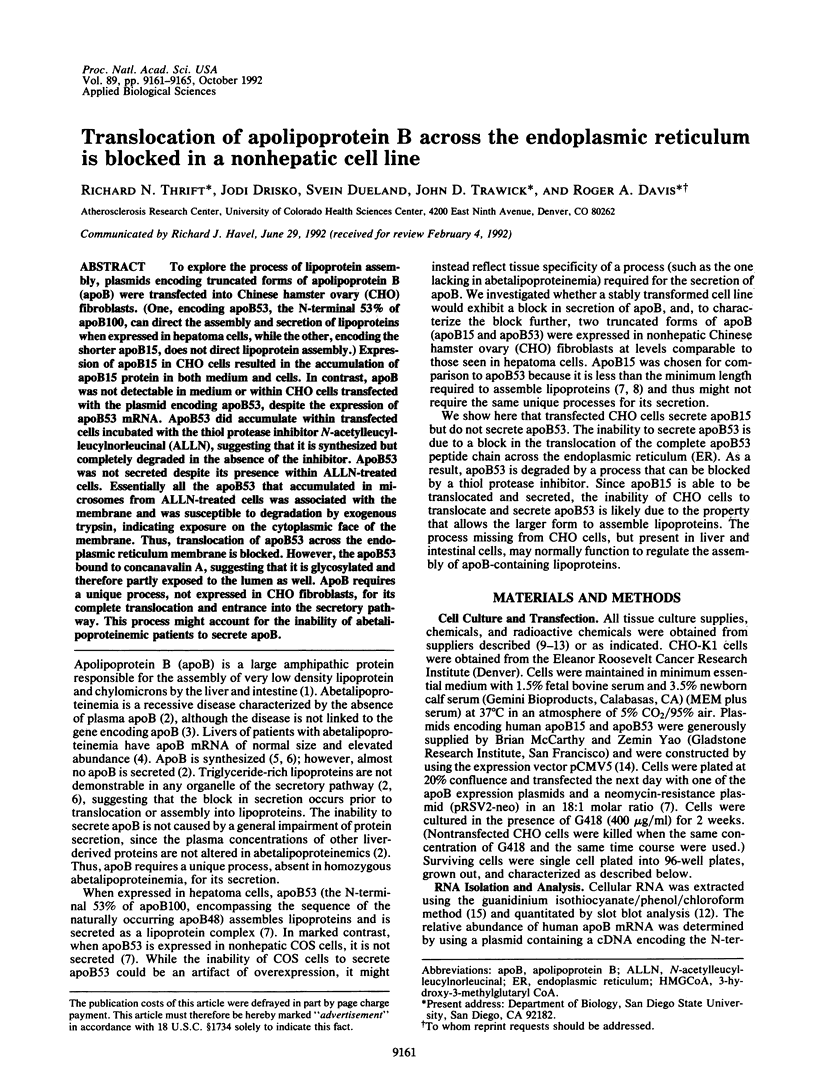
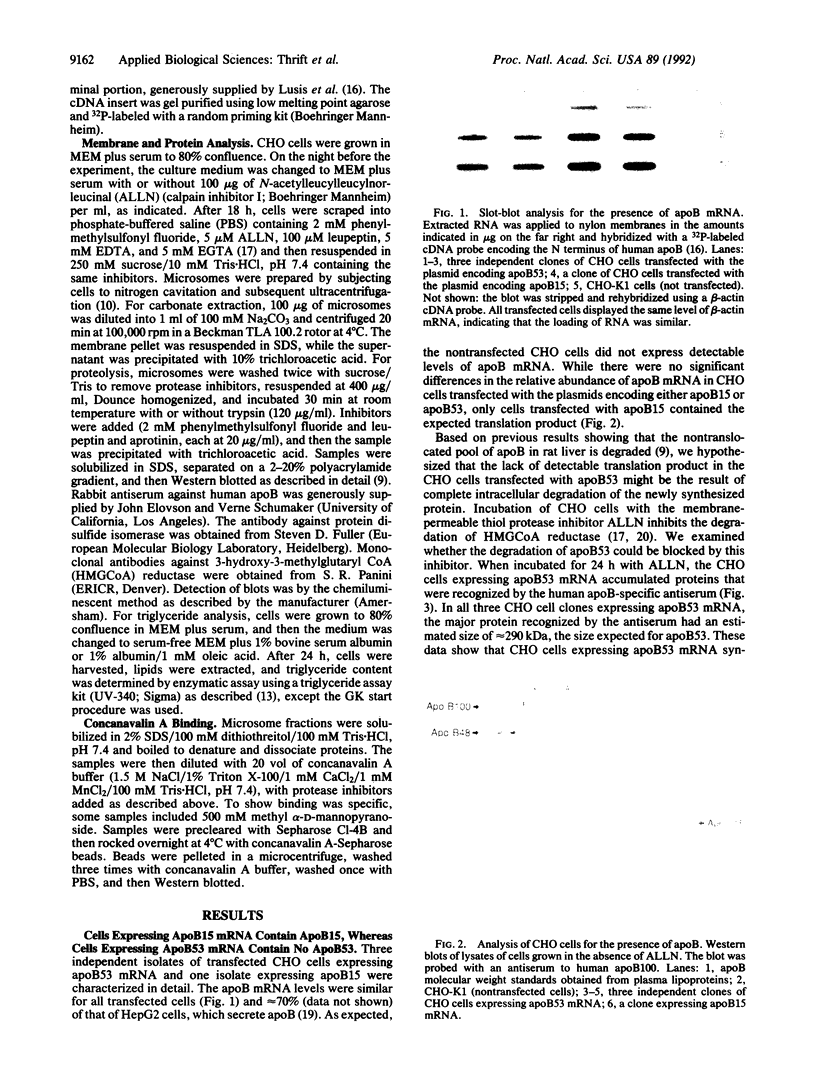
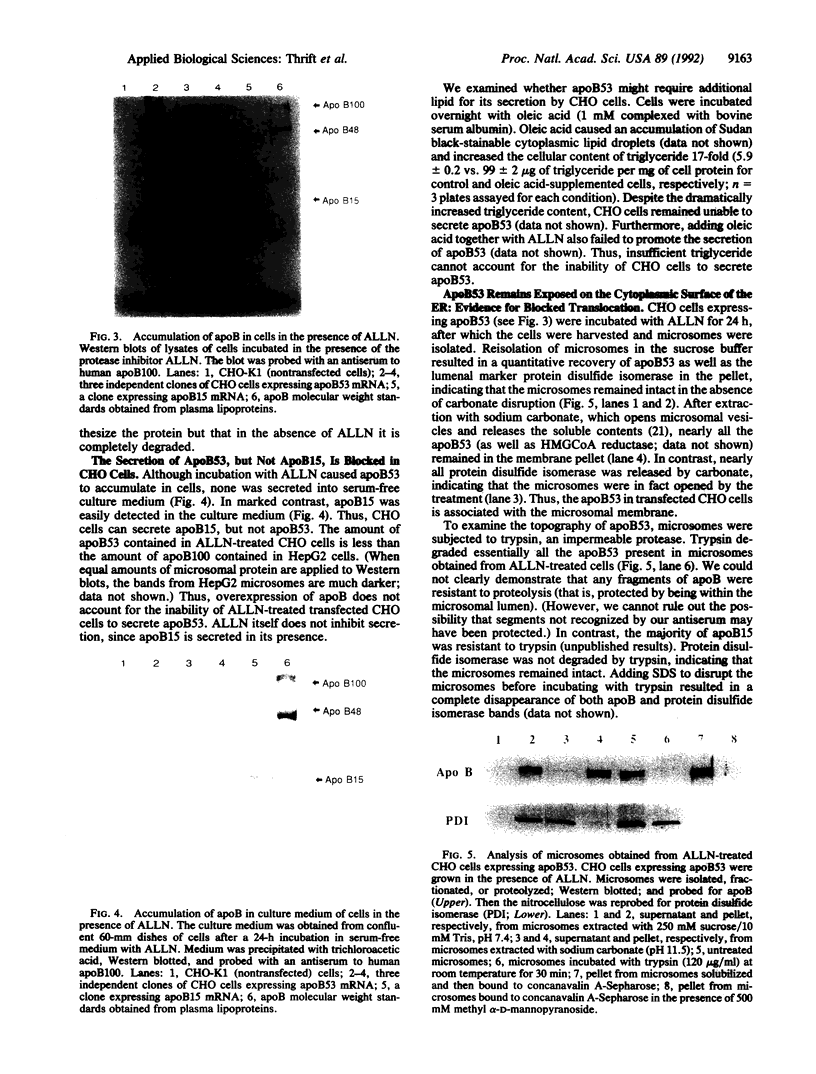
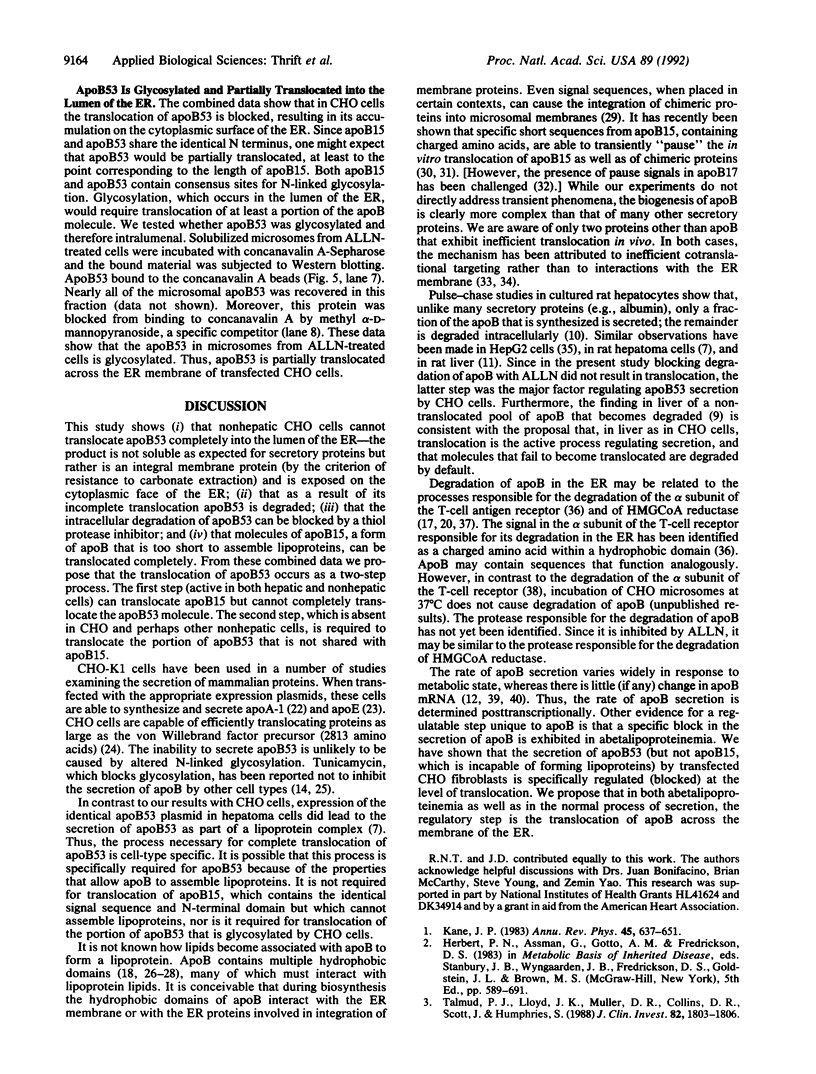
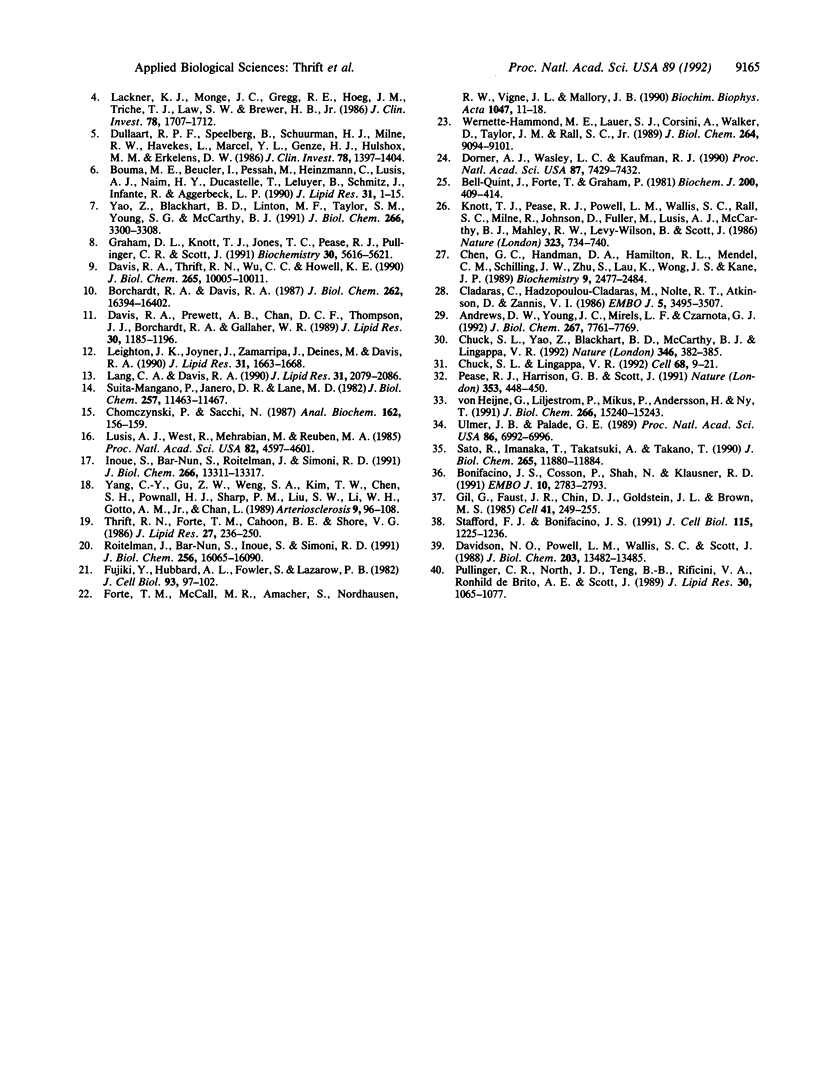
Images in this article
Selected References
These references are in PubMed. This may not be the complete list of references from this article.
- Andrews D. W., Young J. C., Mirels L. F., Czarnota G. J. The role of the N region in signal sequence and signal-anchor function. J Biol Chem. 1992 Apr 15;267(11):7761–7769. [PubMed] [Google Scholar]
- Bell-Quint J., Forte T., Graham P. Glycosylation of apolipoproteins by cultured rat hepatocytes. Effect of tunicamycin on lipoprotein secretion. Biochem J. 1981 Nov 15;200(2):409–414. doi: 10.1042/bj2000409. [DOI] [PMC free article] [PubMed] [Google Scholar]
- Bonifacino J. S., Cosson P., Shah N., Klausner R. D. Role of potentially charged transmembrane residues in targeting proteins for retention and degradation within the endoplasmic reticulum. EMBO J. 1991 Oct;10(10):2783–2793. doi: 10.1002/j.1460-2075.1991.tb07827.x. [DOI] [PMC free article] [PubMed] [Google Scholar]
- Borchardt R. A., Davis R. A. Intrahepatic assembly of very low density lipoproteins. Rate of transport out of the endoplasmic reticulum determines rate of secretion. J Biol Chem. 1987 Dec 5;262(34):16394–16402. [PubMed] [Google Scholar]
- Bouma M. E., Beucler I., Pessah M., Heinzmann C., Lusis A. J., Naim H. Y., Ducastelle T., Leluyer B., Schmitz J., Infante R. Description of two different patients with abetalipoproteinemia: synthesis of a normal-sized apolipoprotein B-48 in intestinal organ culture. J Lipid Res. 1990 Jan;31(1):1–15. [PubMed] [Google Scholar]
- Chen G. C., Hardman D. A., Hamilton R. L., Mendel C. M., Schilling J. W., Zhu S., Lau K., Wong J. S., Kane J. P. Distribution of lipid-binding regions in human apolipoprotein B-100. Biochemistry. 1989 Mar 21;28(6):2477–2484. doi: 10.1021/bi00432a019. [DOI] [PubMed] [Google Scholar]
- Chomczynski P., Sacchi N. Single-step method of RNA isolation by acid guanidinium thiocyanate-phenol-chloroform extraction. Anal Biochem. 1987 Apr;162(1):156–159. doi: 10.1006/abio.1987.9999. [DOI] [PubMed] [Google Scholar]
- Chuck S. L., Lingappa V. R. Pause transfer: a topogenic sequence in apolipoprotein B mediates stopping and restarting of translocation. Cell. 1992 Jan 10;68(1):9–21. doi: 10.1016/0092-8674(92)90202-n. [DOI] [PubMed] [Google Scholar]
- Chuck S. L., Yao Z., Blackhart B. D., McCarthy B. J., Lingappa V. R. New variation on the translocation of proteins during early biogenesis of apolipoprotein B. Nature. 1990 Jul 26;346(6282):382–385. doi: 10.1038/346382a0. [DOI] [PubMed] [Google Scholar]
- Cladaras C., Hadzopoulou-Cladaras M., Nolte R. T., Atkinson D., Zannis V. I. The complete sequence and structural analysis of human apolipoprotein B-100: relationship between apoB-100 and apoB-48 forms. EMBO J. 1986 Dec 20;5(13):3495–3507. doi: 10.1002/j.1460-2075.1986.tb04675.x. [DOI] [PMC free article] [PubMed] [Google Scholar]
- Davidson N. O., Powell L. M., Wallis S. C., Scott J. Thyroid hormone modulates the introduction of a stop codon in rat liver apolipoprotein B messenger RNA. J Biol Chem. 1988 Sep 25;263(27):13482–13485. [PubMed] [Google Scholar]
- Davis R. A., Prewett A. B., Chan D. C., Thompson J. J., Borchardt R. A., Gallaher W. R. Intrahepatic assembly of very low density lipoproteins: immunologic characterization of apolipoprotein B in lipoproteins and hepatic membrane fractions and its intracellular distribution. J Lipid Res. 1989 Aug;30(8):1185–1196. [PubMed] [Google Scholar]
- Davis R. A., Thrift R. N., Wu C. C., Howell K. E. Apolipoprotein B is both integrated into and translocated across the endoplasmic reticulum membrane. Evidence for two functionally distinct pools. J Biol Chem. 1990 Jun 15;265(17):10005–10011. [PubMed] [Google Scholar]
- Dorner A. J., Wasley L. C., Kaufman R. J. Protein dissociation from GRP78 and secretion are blocked by depletion of cellular ATP levels. Proc Natl Acad Sci U S A. 1990 Oct;87(19):7429–7432. doi: 10.1073/pnas.87.19.7429. [DOI] [PMC free article] [PubMed] [Google Scholar]
- Dullaart R. P., Speelberg B., Schuurman H. J., Milne R. W., Havekes L. M., Marcel Y. L., Geuze H. J., Hulshof M. M., Erkelens D. W. Epitopes of apolipoprotein B-100 and B-48 in both liver and intestine. Expression and evidence for local synthesis in recessive abetalipoproteinemia. J Clin Invest. 1986 Nov;78(5):1397–1404. doi: 10.1172/JCI112727. [DOI] [PMC free article] [PubMed] [Google Scholar]
- Forte T. M., McCall M. R., Amacher S., Nordhausen R. W., Vigne J. L., Mallory J. B. Physical and chemical characteristics of apolipoprotein A-I-lipid complexes produced by Chinese hamster ovary cells transfected with the human apolipoprotein A-I gene. Biochim Biophys Acta. 1990 Oct 22;1047(1):11–18. doi: 10.1016/0005-2760(90)90254-u. [DOI] [PubMed] [Google Scholar]
- Fujiki Y., Hubbard A. L., Fowler S., Lazarow P. B. Isolation of intracellular membranes by means of sodium carbonate treatment: application to endoplasmic reticulum. J Cell Biol. 1982 Apr;93(1):97–102. doi: 10.1083/jcb.93.1.97. [DOI] [PMC free article] [PubMed] [Google Scholar]
- Gil G., Faust J. R., Chin D. J., Goldstein J. L., Brown M. S. Membrane-bound domain of HMG CoA reductase is required for sterol-enhanced degradation of the enzyme. Cell. 1985 May;41(1):249–258. doi: 10.1016/0092-8674(85)90078-9. [DOI] [PubMed] [Google Scholar]
- Graham D. L., Knott T. J., Jones T. C., Pease R. J., Pullinger C. R., Scott J. Carboxyl-terminal truncation of apolipoprotein B results in gradual loss of the ability to form buoyant lipoproteins in cultured human and rat liver cell lines. Biochemistry. 1991 Jun 4;30(22):5616–5621. doi: 10.1021/bi00236a040. [DOI] [PubMed] [Google Scholar]
- Inoue S., Bar-Nun S., Roitelman J., Simoni R. D. Inhibition of degradation of 3-hydroxy-3-methylglutaryl-coenzyme A reductase in vivo by cysteine protease inhibitors. J Biol Chem. 1991 Jul 15;266(20):13311–13317. [PubMed] [Google Scholar]
- Kane J. P. Apolipoprotein B: structural and metabolic heterogeneity. Annu Rev Physiol. 1983;45:637–650. doi: 10.1146/annurev.ph.45.030183.003225. [DOI] [PubMed] [Google Scholar]
- Knott T. J., Pease R. J., Powell L. M., Wallis S. C., Rall S. C., Jr, Innerarity T. L., Blackhart B., Taylor W. H., Marcel Y., Milne R. Complete protein sequence and identification of structural domains of human apolipoprotein B. Nature. 1986 Oct 23;323(6090):734–738. doi: 10.1038/323734a0. [DOI] [PubMed] [Google Scholar]
- Lackner K. J., Monge J. C., Gregg R. E., Hoeg J. M., Triche T. J., Law S. W., Brewer H. B., Jr Analysis of the apolipoprotein B gene and messenger ribonucleic acid in abetalipoproteinemia. J Clin Invest. 1986 Dec;78(6):1707–1712. doi: 10.1172/JCI112766. [DOI] [PMC free article] [PubMed] [Google Scholar]
- Lang C. A., Davis R. A. Fish oil fatty acids impair VLDL assembly and/or secretion by cultured rat hepatocytes. J Lipid Res. 1990 Nov;31(11):2079–2086. [PubMed] [Google Scholar]
- Leighton J. K., Joyner J., Zamarripa J., Deines M., Davis R. A. Fasting decreases apolipoprotein B mRNA editing and the secretion of small molecular weight apoB by rat hepatocytes: evidence that the total amount of apoB secreted is regulated post-transcriptionally. J Lipid Res. 1990 Sep;31(9):1663–1668. [PubMed] [Google Scholar]
- Lusis A. J., West R., Mehrabian M., Reuben M. A., LeBoeuf R. C., Kaptein J. S., Johnson D. F., Schumaker V. N., Yuhasz M. P., Schotz M. C. Cloning and expression of apolipoprotein B, the major protein of low and very low density lipoproteins. Proc Natl Acad Sci U S A. 1985 Jul;82(14):4597–4601. doi: 10.1073/pnas.82.14.4597. [DOI] [PMC free article] [PubMed] [Google Scholar]
- Pease R. J., Harrison G. B., Scott J. Cotranslocational insertion of apolipoprotein B into the inner leaflet of the endoplasmic reticulum. Nature. 1991 Oct 3;353(6343):448–450. doi: 10.1038/353448a0. [DOI] [PMC free article] [PubMed] [Google Scholar]
- Pullinger C. R., North J. D., Teng B. B., Rifici V. A., Ronhild de Brito A. E., Scott J. The apolipoprotein B gene is constitutively expressed in HepG2 cells: regulation of secretion by oleic acid, albumin, and insulin, and measurement of the mRNA half-life. J Lipid Res. 1989 Jul;30(7):1065–1077. [PubMed] [Google Scholar]
- Sato R., Imanaka T., Takatsuki A., Takano T. Degradation of newly synthesized apolipoprotein B-100 in a pre-Golgi compartment. J Biol Chem. 1990 Jul 15;265(20):11880–11884. [PubMed] [Google Scholar]
- Siuta-Mangano P., Janero D. R., Lane M. D. Association and assembly of triglyceride and phospholipid with glycosylated and unglycosylated apoproteins of very low density lipoprotein in the intact liver cell. J Biol Chem. 1982 Oct 10;257(19):11463–11467. [PubMed] [Google Scholar]
- Stafford F. J., Bonifacino J. S. A permeabilized cell system identifies the endoplasmic reticulum as a site of protein degradation. J Cell Biol. 1991 Dec;115(5):1225–1236. doi: 10.1083/jcb.115.5.1225. [DOI] [PMC free article] [PubMed] [Google Scholar]
- Talmud P. J., Lloyd J. K., Muller D. P., Collins D. R., Scott J., Humphries S. Genetic evidence from two families that the apolipoprotein B gene is not involved in abetalipoproteinemia. J Clin Invest. 1988 Nov;82(5):1803–1806. doi: 10.1172/JCI113795. [DOI] [PMC free article] [PubMed] [Google Scholar]
- Thrift R. N., Forte T. M., Cahoon B. E., Shore V. G. Characterization of lipoproteins produced by the human liver cell line, Hep G2, under defined conditions. J Lipid Res. 1986 Mar;27(3):236–250. [PubMed] [Google Scholar]
- Ulmer J. B., Palade G. E. Targeting and processing of glycophorins in murine erythroleukemia cells: use of brefeldin A as a perturbant of intracellular traffic. Proc Natl Acad Sci U S A. 1989 Sep;86(18):6992–6996. doi: 10.1073/pnas.86.18.6992. [DOI] [PMC free article] [PubMed] [Google Scholar]
- Wernette-Hammond M. E., Lauer S. J., Corsini A., Walker D., Taylor J. M., Rall S. C., Jr Glycosylation of human apolipoprotein E. The carbohydrate attachment site is threonine 194. J Biol Chem. 1989 May 25;264(15):9094–9101. [PubMed] [Google Scholar]
- Yang C. Y., Gu Z. W., Weng S. A., Kim T. W., Chen S. H., Pownall H. J., Sharp P. M., Liu S. W., Li W. H., Gotto A. M., Jr Structure of apolipoprotein B-100 of human low density lipoproteins. Arteriosclerosis. 1989 Jan-Feb;9(1):96–108. doi: 10.1161/01.atv.9.1.96. [DOI] [PubMed] [Google Scholar]
- Yao Z. M., Blackhart B. D., Linton M. F., Taylor S. M., Young S. G., McCarthy B. J. Expression of carboxyl-terminally truncated forms of human apolipoprotein B in rat hepatoma cells. Evidence that the length of apolipoprotein B has a major effect on the buoyant density of the secreted lipoproteins. J Biol Chem. 1991 Feb 15;266(5):3300–3308. [PubMed] [Google Scholar]
- von Heijne G., Liljeström P., Mikus P., Andersson H., Ny T. The efficiency of the uncleaved secretion signal in the plasminogen activator inhibitor type 2 protein can be enhanced by point mutations that increase its hydrophobicity. J Biol Chem. 1991 Aug 15;266(23):15240–15243. [PubMed] [Google Scholar]







